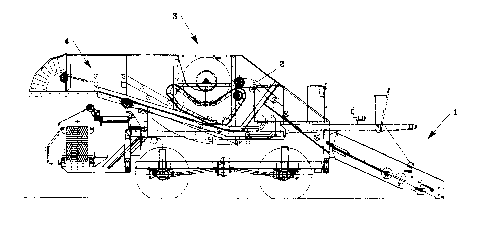Some of the information on this Web page has been provided by external sources. The Government of Canada is not responsible for the accuracy, reliability or currency of the information supplied by external sources. Users wishing to rely upon this information should consult directly with the source of the information. Content provided by external sources is not subject to official languages, privacy and accessibility requirements.
Any discrepancies in the text and image of the Claims and Abstract are due to differing posting times. Text of the Claims and Abstract are posted:
| (12) Patent Application: | (11) CA 2307543 |
|---|---|
| (54) English Title: | TOMATO HARVESTER WITH IMPROVED DEVICES FOR FEEDING CUT PLANTS TO THE SHAKER |
| (54) French Title: | RECOLTEUSE DE TOMATES AVEC DISPOSITIFS AMELIORES POUR LE TRANSPORT DES PLANTS COUPES VERS L'AGITATEUR |
| Status: | Deemed Abandoned and Beyond the Period of Reinstatement - Pending Response to Notice of Disregarded Communication |
| (51) International Patent Classification (IPC): |
|
|---|---|
| (72) Inventors : |
|
| (73) Owners : |
|
| (71) Applicants : |
|
| (74) Agent: | ROBIC AGENCE PI S.E.C./ROBIC IP AGENCY LP |
| (74) Associate agent: | |
| (45) Issued: | |
| (22) Filed Date: | 2000-05-04 |
| (41) Open to Public Inspection: | 2001-11-04 |
| Examination requested: | 2005-03-14 |
| Availability of licence: | N/A |
| Dedicated to the Public: | N/A |
| (25) Language of filing: | English |
| Patent Cooperation Treaty (PCT): | No |
|---|
| (30) Application Priority Data: | None |
|---|
The invention relates to a tomato harvester which includes:
~ loading systems designed to receive the cut plants and direct them into
the harvester
~ shaker devices constituted by a number of sets of rods fitted radially on
a common rotating support which are subject to the action of systems
designed to make them vibrate
~ a feed belt designed to receive the plants from the said loading
systems and convey them to the said shaker, following the route of the
said shaker rods perimetrically
~ a number of support elements constituted by hoses or the like made of
flexible material, guided by rings fitted to the ends of a set of arms
integral with the said conveyor belt which are fitted in staggered
positions in relation to shaker rods so as to form a grid that supports the
plants at a certain distance from the said feed belt
~ systems designed to receive and discharge the plants stripped of fruit.
Note: Claims are shown in the official language in which they were submitted.
Note: Descriptions are shown in the official language in which they were submitted.

2024-08-01:As part of the Next Generation Patents (NGP) transition, the Canadian Patents Database (CPD) now contains a more detailed Event History, which replicates the Event Log of our new back-office solution.
Please note that "Inactive:" events refers to events no longer in use in our new back-office solution.
For a clearer understanding of the status of the application/patent presented on this page, the site Disclaimer , as well as the definitions for Patent , Event History , Maintenance Fee and Payment History should be consulted.
| Description | Date |
|---|---|
| Inactive: IPC assigned | 2024-04-05 |
| Inactive: IPC expired | 2018-01-01 |
| Inactive: IPC removed | 2017-12-31 |
| Application Not Reinstated by Deadline | 2008-08-05 |
| Inactive: Dead - No reply to s.30(2) Rules requisition | 2008-08-05 |
| Deemed Abandoned - Failure to Respond to Maintenance Fee Notice | 2008-05-05 |
| Inactive: Abandoned - No reply to s.30(2) Rules requisition | 2007-08-06 |
| Inactive: S.30(2) Rules - Examiner requisition | 2007-02-05 |
| Letter Sent | 2005-03-29 |
| All Requirements for Examination Determined Compliant | 2005-03-14 |
| Request for Examination Received | 2005-03-14 |
| Request for Examination Requirements Determined Compliant | 2005-03-14 |
| Letter Sent | 2003-10-10 |
| Inactive: Multiple transfers | 2003-09-02 |
| Inactive: Cover page published | 2001-11-04 |
| Application Published (Open to Public Inspection) | 2001-11-04 |
| Inactive: IPC assigned | 2000-07-13 |
| Inactive: IPC assigned | 2000-07-13 |
| Inactive: First IPC assigned | 2000-07-13 |
| Inactive: Filing certificate - No RFE (English) | 2000-06-16 |
| Letter Sent | 2000-06-16 |
| Application Received - Regular National | 2000-06-09 |
| Abandonment Date | Reason | Reinstatement Date |
|---|---|---|
| 2008-05-05 |
The last payment was received on 2007-02-02
Note : If the full payment has not been received on or before the date indicated, a further fee may be required which may be one of the following
Patent fees are adjusted on the 1st of January every year. The amounts above are the current amounts if received by December 31 of the current year.
Please refer to the CIPO
Patent Fees
web page to see all current fee amounts.
| Fee Type | Anniversary Year | Due Date | Paid Date |
|---|---|---|---|
| Application fee - standard | 2000-05-04 | ||
| Registration of a document | 2000-05-04 | ||
| MF (application, 2nd anniv.) - standard | 02 | 2002-05-06 | 2002-03-04 |
| MF (application, 3rd anniv.) - standard | 03 | 2003-05-05 | 2003-02-03 |
| MF (application, 4th anniv.) - standard | 04 | 2004-05-04 | 2004-02-10 |
| Request for examination - standard | 2005-03-14 | ||
| MF (application, 5th anniv.) - standard | 05 | 2005-05-04 | 2005-03-24 |
| MF (application, 6th anniv.) - standard | 06 | 2006-05-04 | 2006-04-04 |
| MF (application, 7th anniv.) - standard | 07 | 2007-05-04 | 2007-02-02 |
Note: Records showing the ownership history in alphabetical order.
| Current Owners on Record |
|---|
| FMC TECHNOLOGIES ITALIA S.P.A. |
| Past Owners on Record |
|---|
| LUIGI SANDEI |